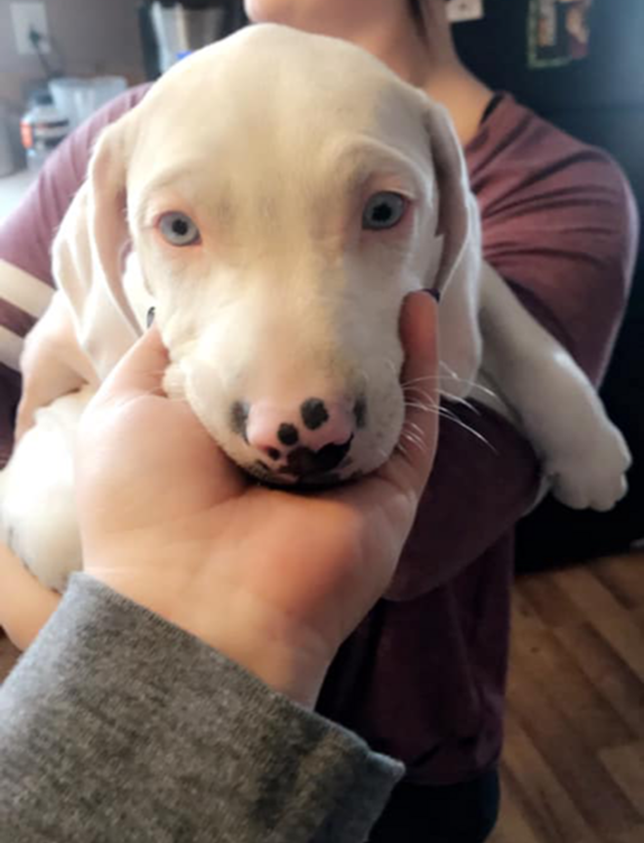Double Merle Awareness
By Penny Thompson, Hobo’s Healing Heart Board Member
Your heart grows ten times bigger when it comes to loving and caring for a double merle dog. At least, that’s what I truly believe—it’s certainly been the case for me. This is my story of how I came to learn about the specific genome known as the “double merle gene” in dogs, and my journey to understanding the science behind what makes a double merle. I’ll share training tips I’ve learned along the way and safety measures to practice while caring for these special dogs—so they can still enjoy all the things other dogs do—with the added care and precautions they require.
My Story:
In January 2018, we had just lost our Australian Border Collie/Lab mix very suddenly. Our hearts were broken—we were missing our boy deeply. My husband suggested visiting our local humane society after seeing a puppy on their website.
We walked in asking to meet “Wilber,” a 12- to 13-week-old Catahoula mix puppy. Oh, how our hearts burst at the sight of him!
The assistant at the humane society informed us that he was deaf, and if we wanted to adopt him, it would be for a trial period. He would need extensive training to keep him safe in the world. We took him home for the weekend—and he ended up becoming part of our family instantly. We renamed him Grey.
Just a year later, in November, another double merle came into our lives: Juvia. She was around 8 to 9 months old and came with some training already.
Baby Juvia
When bringing home a deaf and/or blind dog, certain precautions are essential to keep them safe—and to keep your own sanity! Baby gates were incredibly helpful in keeping her from going places she shouldn’t. I also strongly recommend designating specific “dog-safe areas,” especially since Juvia had ended up in the shelter after getting loose and getting into the garbage.
Keeping a consistent routine helped a lot with her training, and being mindful of our movements and facial expressions was key—quick gestures could easily startle or scare her.
What is a Double Merle?
It wasn’t until a friend pointed out Grey’s unique coloring and impairments that I first heard the term “double merle.” So, what exactly does it mean?
A double merle is created when two merle-patterned dogs (dogs with marbled coat coloring) are bred together. It doesn’t matter what color or breed they are. When this happens, each puppy in the litter has a 25% chance of inheriting the merle gene twice—once from each parent.
One copy of the merle gene causes a marbling effect in the coat, producing lighter patches throughout. When doubled, the lightening is intensified, often leaving the coat predominantly white. Their eyes are typically sky-blue. Sadly, double merles have a high chance of being deaf, blind, or both due to the lack of pigmentation in critical areas like the ears and eyes.
Because of these impairments, they’re especially sensitive to sun exposure, particularly around their eyes and noses. Tragically, many double merles don’t get adopted and are often euthanized because they are not seen as “valuable” to the average family.
But for those of us who have been blessed with a double merle, we know how incredibly loved they are. There is a whole online community dedicated to supporting owners of double merles—and even a Double Merle Awareness Day, celebrated annually on the third weekend in May.
Training and Helpful Tips
Double merles are just as capable as other dogs—and often compete in agility, cart-pulling, K9 nose work, and even serve as therapy dogs. They just need to be trained a little differently.
These dogs respond best to hand signals or sign language. Vibration and lights can also be helpful tools. Microchipping is a must, as it greatly increases the chances of being reunited with your dog if they ever get loose. Hobo’s Healing Heart offers low-cost microchipping as part of their commitment to promoting responsible pet ownership and keeping pets safe.
I had to quickly learn some basic sign language and body cues to help Grey learn his “do’s and don’ts.” In my experience, it’s important for at least one family member to spend consistent time with the dog daily. That helps you understand how your dog communicates—how they tell you they need to go potty, when it’s playtime, or when they need reassurance.
Having other dogs in the home can also help, as the double merle can mirror their behavior and learn from them. Walks are great for double merles, just like for any dog.
Want to help keep your dog safe while out and about? Try no-pull harnesses and clearly labeled leashes or collars that say “Deaf Dog.” Some owners also find vibrating training collars helpful. Protect their eyes with doggie sunglasses or shaded goggles.
Double merles don’t care that they can’t hear—or even see. They’re just happy to be loved and are ready to live life to the fullest!
Helpful Links:
• Harness: Best Dog Harness | Ask Canine
• Doggie Sunglasses/Shaded Goggles
Disclaimer:
This is based on my personal experience, along with research I’ve gathered on the double merle gene in dogs.





